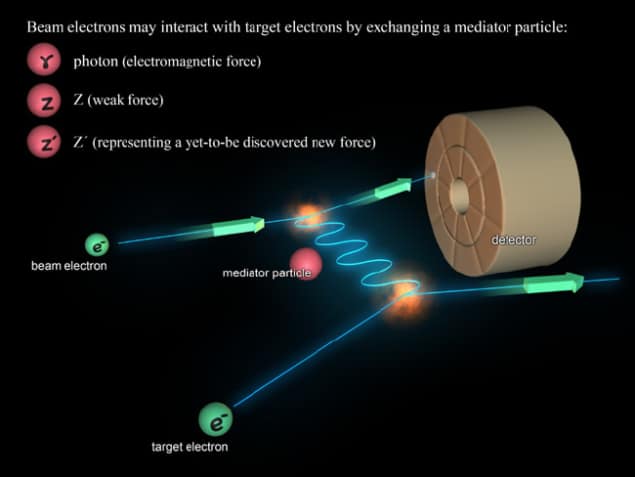An international collaboration of particle physicists has made new measurements that shed more light on the weak force, which is responsible for radioactive beta-decay. The results, which agree with the Standard Model, show that the strength of the weak force acting on two electrons lessens when the electrons are far apart (hep-ex/0504049). "Physicists have long expected that the weak-force interactions would be weaker at longer distances, but proving it wasn't easy," says experiment co-spokesman Krishna Kumar, who is at the University of Massachusetts-Amherst.

In the E158 experiment at the Stanford Linear Accelerator Center (SLAC), a high-energy beam of electrons is fired at a liquid hydrogen target. The beam is polarized with the spins of the electrons either pointing in the same direction as the beam (so-called right-handed polarization) or in the opposite direction (left-handed polarization). The vast majority of electrons scatter off electrons in the target by exchanging a photon, but very occasionally an electron does so by exchanging a Z boson instead.
The aim of the experiment was to measure the tiny difference, or asymmetry, in how often right- and left-handed electrons scatter by exchanging a Z boson. On average, a bunch of right-handed electrons generates 20 million scattering events, of which just a few dozen are mediated by Z bosons. Left-handed bunches yield about five more Z-mediated scatters. This slight asymmetry — known as “parity” violation — is about 131 parts per billion in electron-electron interactions. Parity is violated by the weak interaction but conserved by gravity, the electromagnetic interaction and the strong force.
The measured asymmetry in E158 is proportional to the electron’s weak charge, which is a measure of the strength of the weak interaction between two electrons. Previous experiments at SLAC and CERN in Geneva measured the weak charge at “short” distances of about one hundredth of the width of the proton. E158 has now shown that at “long” distances — roughly 10 times the width of the proton — the weak charge is only half the size of the charge at short distances.
The experiment establishes for the first time that the weak charge on the electron varies with distance — a phenomenon called “running”. “Their high precision measurement of a tiny parity-violating asymmetry provides one of the best tests of the Standard Model and confirms the expected running of the weak charge,” adds Bill Marciano, who is senior theoretical physicist at Brookhaven National Laboratory.




